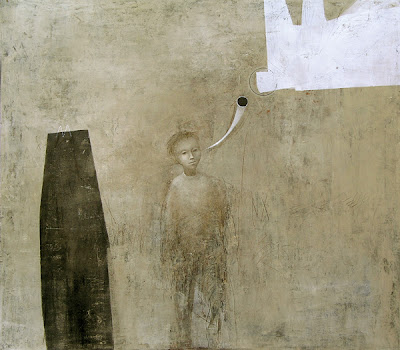About Terenin
Alexey Terenin luckily combines the architect’s training and painter’s practice in his work, which embraces the aesthetic environment of modern man.
Having got the education at the Moscow Architectural Institute in 1986-1993 Alexey Terenin started his career of exhibiting graphic artist and painter in 1992 with most prominent Moscow galleries Art Moderne and M’ARS.
Grown up Prague and living in Moscow he as an artist has become a digger for the layers of imagination that can never be identified historically, but absorbed the heritage of many cultures of the West and East. The language of reminiscence and association chosen by the artist enabled him to build up a big city of dreams inhabited with the ghosts of the past and heroes of the present in the most peculiar and unpredictable way. In the depths of his fantasy the artist was given a power to choose the time, the place and the rules of the game and then to set off to a journey with his personages.
Prague surely inspired Terenin’s “Gothic” expressiveness, while Moscow gave him the constant sense of interlacement of epochs, that history’s masquerade, which is obviously present in his paintings. The artist found his own way of discovering the world. A mask, instead of concealing and hiding the meanings, became a sign, a symbol, and an image of reality, which otherwise in this way or another escapes our comprehension, and only the mask provides us the understanding of the theater of life.
Not accidentally Terenin worked for the theater, the Bolshoj Theater of Moscow. Scenery may serve the key world for his work, be it interior mural, easel painting, or furniture design. There is no literature, no subject, but only a situation. Narration is left up to some unknown and independent playwright. The abovementioned pictorial journey endeavored by Terenin’s personages can be only possible if the artist and the viewer know nothing about the end of it. Also the attaching of meanings and titles is in discord with the nature of the game. What we have for sure is the perfect architectonics of the newly discovered world that anyone could probably have seen in some other life.
Alexei Vakhmanov
Alexey Terenin’s Exhibitions.
1992 - M'ARS gallery,Moscow.
1993 - Joint exhibition "Lilja Zakirova Art" Overlun, Netherlands.
Joint exhibition "Post-Immoderacy", M'ARS gallery, Moscow.
M'ARS gallery,Moscow.
1994 - MIMO gallery, Prague.
M'ARS gallery, Moscow.
"Jakubska" gallery, Prague.
"Russian Collection-End of XX Century", M'ARS gallery, Moscow.
"REF. Kirchgemeindehaus zum Guggel", Basel, Switzerland.
"Christmas Fantasies", Lobby Gallery, New York City.
1995 - NB gallery, Moscow.
M'ARS gallery, Moscow.
1996 - Art Expo, New York City.
Central House of Artists gallery, Moscow.
"Michalska" gallery, Prague.
Exhibition (graphics), Central House of Artists gallery, Moscow.
"Jakubska" gallery, Prague, Czech Republic.
1997 - Joint exhibition "Russian Collection in the Palace of Nations", Geneva.
Joint exhibition, "Windows", "Belyaevo" gallery, Moscow.
Joint exhibition, "The World of Sensual Things in Pictures - the End of XX Century", Pushkin State Museum of Fine Arts, Moscow.
Art Director in "Capriccio" ballet by Stravinsky, Bolshoi Theatre, Moscow.
Art-Manezh-97 exhibition, Moscow.
1998 - Art-Manezh-98 exhibition, Moscow.
Joint exhibition in exhibition hall "Usadyba Golizino", Moscow.
1999 - Joint exhibition in "Redisson-Slavyanskaya" hotel, Moscow.
M'ARS gallery, Moscow.
2000 - International Foundation of Culture, Moscow.
Ash Information Centre gallery, Ash city, Chech Republic.
"Art CDKh" International Art Fair, Central House of Artists gallery, Moscow.
"X-Art" gallery, Amsterdam, Netherlands.
2002 - "Jakubska" gallery, Prague.
"MIMO" gallery, Prague.
Joint exhibition "Russian Spring", "Fortnum and Mason PLC", London, UK.
"Ve vezi"gallery, Melnik, Czech Republic.
"4.KUNSTMESSE", Berlin, Germany.
International Festival of Nonverbal Theatre, Kolin, Czech Republic.
2003 - "Colliers" gallery, Newcastle, UK.
"ALBERMARLE" gallery, London, UK.
Joint exhibition "Russian Charm", The Inter-Continental Hotel, London, UK.
Private exhibition, Gevelsberg, Germany.
2004 - "MaxArt" gallery, Prague, Czech Repablic.
European prize for fine arts by the European union of arts. Prague.
Joint exhibition "50 works of fine art from Russia", Maison du Monde, London.
"Cerna Labut" gallery, Prague, Czech Republic.
2005 - Joint exhibition Collyer-Bristow Gallery, London
Joint exhibition "The Biscuit Factory" Gallery, Newcastle(Great Britain)
Jorgensen Fine Art Gallery, Dublin
Gallery in VHS 3 Volkshochschule, Wien
2006 - Gallery C.A.O.S., Rome, Italy
Galerie Lamber, Valkenswaard, Netherlands
Galerie Image, Wien Austria
Galerie de Arte Carmen Terreros Andreu, Zaragoza, Spain
Joint exhibition: Medici Gallery, London, UK
Joint exhibition: "The Biscuit Factory" Gallery, Newcastle, UK
2007 - Gallery Hannah, Herent (Belgium)
Affordable Art Fair, London
2008 - Affordable Art Fair, London
Affordable Art Fair, Paris
Affordable Art Fair, New York
Bohemia Galleries, East Yorkshire, UK
The Oriel Gallery, Dublin , Ireland.
Copyright ©













































































